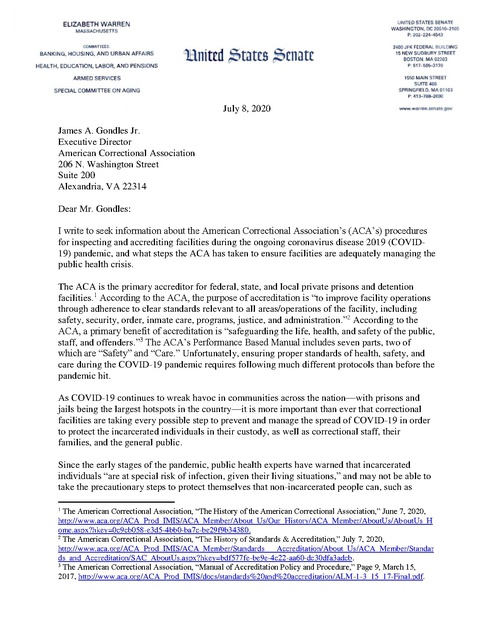Letter to American Correctional Association (ACA) Re Accreditation During COVID-19 Pandemic, July 2020
Download original document:

Document text

Document text
This text is machine-read, and may contain errors. Check the original document to verify accuracy.
UNlfEC.> STATES srnATF. WASKIN GTON, DC 20510-2105 ELIZABETH WARREN MASSACKUSETTS COMM1 nrcs BANKING. HOUSING. AND URBAN AFFAIRS HEALTH, EDUCATION, LABOR, AND PENSIONS P: 202- 224-4543 tinitrd ~tatts ~cnatc 2400 JFK ~WERAL BUILDING 15 NEW SUDBURY STREET BOSTON. M A 02203 P: 617- 565-3170 ARMED SERVICES 1550 MAIN STREET SPECIAL COMMITTEE ON AGING SUITE 4l>6 SPRINGFIELD, MA 01103 P: 41 3--7811--2690 July 8, 2020 www.werreri.senate.gov James A. Gondles Jr. Executive Director American Correctional Association 206 N. Washington Street Suite 200 Alexandria, VA 22314 Dear Mr. Gondles: I write to seek information about the American Correctional Association’s (ACA’s) procedures for inspecting and accrediting facilities during the ongoing coronavirus disease 2019 (COVID19) pandemic, and what steps the ACA has taken to ensure facilities are adequately managing the public health crisis. The ACA is the primary accreditor for federal, state, and local private prisons and detention facilities.1 According to the ACA, the purpose of accreditation is “to improve facility operations through adherence to clear standards relevant to all areas/operations of the facility, including safety, security, order, inmate care, programs, justice, and administration.”2 According to the ACA, a primary benefit of accreditation is “safeguarding the life, health, and safety of the public, staff, and offenders.”3 The ACA’s Performance Based Manual includes seven parts, two of which are “Safety” and “Care.” Unfortunately, ensuring proper standards of health, safety, and care during the COVID-19 pandemic requires following much different protocols than before the pandemic hit. As COVID-19 continues to wreak havoc in communities across the nation—with prisons and jails being the largest hotspots in the country—it is more important than ever that correctional facilities are taking every possible step to prevent and manage the spread of COVID-19 in order to protect the incarcerated individuals in their custody, as well as correctional staff, their families, and the general public. Since the early stages of the pandemic, public health experts have warned that incarcerated individuals “are at special risk of infection, given their living situations,” and may not be able to take the precautionary steps to protect themselves that non-incarcerated people can, such as The American Correctional Association, “The History of the American Correctional Association,” June 7, 2020, http://www.aca.org/ACA_Prod_IMIS/ACA_Member/About_Us/Our_History/ACA_Member/AboutUs/AboutUs_H ome.aspx?hkey=0c9cb058-e3d5-4bb0-ba7c-be29f9b34380. 2 The American Correctional Association, “The History of Standards & Accreditation,” July 7, 2020, http://www.aca.org/ACA_Prod_IMIS/ACA_Member/Standards___Accreditation/About_Us/ACA_Member/Standar ds_and_Accreditation/SAC_AboutUs.aspx?hkey=bdf577fe-be9e-4c22-aa60-dc30dfa3adcb. 3 The American Correctional Association, “Manual of Accreditation Policy and Procedure,” Page 9, March 15, 2017, http://www.aca.org/ACA_Prod_IMIS/docs/standards%20and%20accreditation/ALM-1-3_15_17-Final.pdf. 1 social distancing measures and increased sanitation practices.4 In addition to their unique vulnerability to contracting and spreading the virus, there are unique challenges to providing adequate medical care for incarcerated individuals who become infected, meaning that “management of this pandemic will be harder and less effective for incarcerated people, their families and staff in these institutions.”5 Unfortunately, these warnings have been borne out, as prisons and jails across the country have become hotspots for the rapid spread of the virus. In fact, prisons and jails are amongst the hardest hit communities in the country, with 12 of the 15 largest COVID-19 “clusters” in the U.S. being correctional facilities—including all five of the largest clusters.6 The Federal Bureau of Prisons (BOP) has also mismanaged the crisis and made matters worse. Last month, the Marshall Project published a report on the BOP’s handling of the COVID-19 outbreak and found that “BOP was unprepared for the pandemic and slow to respond, and that top officials even took measures that contributed to the spread of the virus.”7 As the primary accreditor for prisons, jails, and detention facilities in the U.S., this makes it all the more important that the ACA conduct rigorous oversight of facilities’ responses to the pandemic. To that end, I request that the ACA provide my office with a detailed description of the steps the ACA is taking to ensure that the facilities that it accredits are taking every possible step to prevent and manage the spread of COVID-19, as well as ensuring that facilities provide adequate care to incarcerated individuals in their custody infected with the virus. Please include information on any performance-based measures that have been added or adapted specific to the prevention and management of COVID-19 and how the ACA is continuing to audit and accredit facilities while ensuring the health and safety of detainees, facility staff, and ACA staff. Because this is a time sensitive matter, I ask that you provide your response no later than July 15, 2020. Thank you for your attention to this matter. Sincerely, 4 “Achieving A Fair and Effective COVID-19 Response: An Open Letter to Vice-President Mike Pence, and Other Federal, State and Local Leaders from Public Health and Legal Experts in the United States,” March 2, 2020, https://law.yale.edu/sites/default/files/area/center/ghjp/documents/final_covid19_letter_from_public_health_and_legal_experts.pdf. 5 The Hill, “4 Ways to Protect Our Jails and Prisons From Coronavirus,” Dr. Homer Venters, February 29, 2020, https://thehill.com/opinion/criminal-justice/485236-4-ways-to-protect-our-jails-and-prisons-from-coronavirus. 6 The New York Times, “Coronavirus in the U.S.: Latest Map and Case Count,” Sarah Almukhtar et. al., July 7, 2020, https://www.nytimes.com/interactive/2020/us/coronavirus-us-cases.html#clusters. 7 The Marshall Project, “I Begged Them To Let Me Die”: How Federal Prisons Became Coronavirus Death Traps,” Keri Blakinger and Keegan Hamilton, June 18, 2020, https://www.themarshallproject.org/2020/06/18/i-beggedthem-to-let-me-die-how-federal-prisons-became-coronavirus-death-traps. ___________________________ Elizabeth Warren United States Senator y

